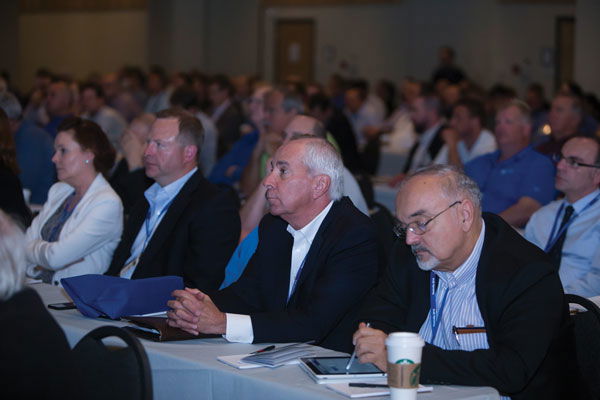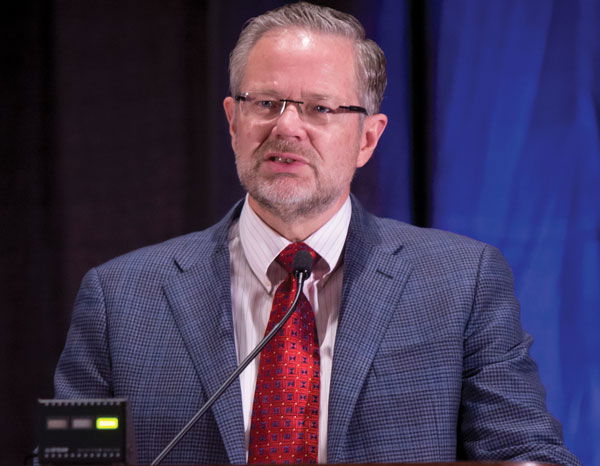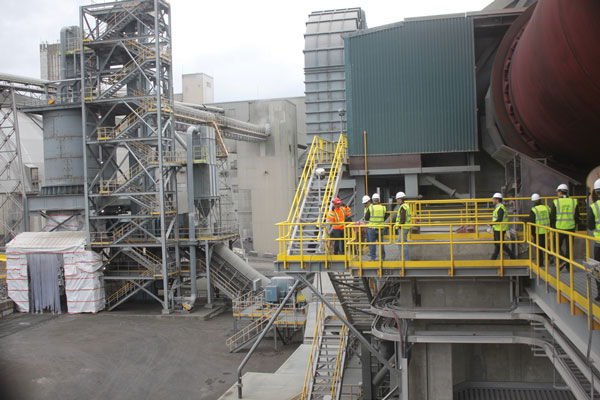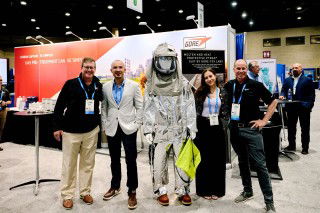The IEEE-IAS/PCA 59th Cement Industry Technical Conference and Exhibition, held in Calgary, Alberta, Canada, on 21-25 May 2017 attracted 833 delegates from 27 countries and was supported by an international exhibition of 149 exhibition stands. Delegates had the choice of attending professional development and process training sessions, as well as participating in two days of technical presentations, three forums and a plant tour of LafargeHolcim’s expanded Exshaw cement plant on the edge of the Rocky Mountains.

Delegates gather for the IEEE-IAS/PCA 59th Cement Industry Technical Conference opening
The 2017 IEEE-IAS/PCA Cement Industry Conference was officially opened by Corinne Fields, IEEE-IAS CIC Chair, on the Tuesday morning, when delegates gathered to hear the welcome address by Conference Organising Committee Chair, Heinz Knopfel.
Mr Knopfel introduced attendees to Calgary, its history as the old capital of Canada, and its wildlife before Mr Michael Sebasto focussed attention on the line up for the Technical Programme of 27 papers and three panel discussions.
State of the industry

Corinne Fields, IEEE-IAS CIC Chair, opens the conference
Ed Sullivan, vice president and chief economist of the PCA, gave his much-anticipated, captivating ‘State of the industry’ keynote speech. Pointing out that while there are always ups and downs in the USA economy, he was proud of the PCA’s historical forecasts and “the one consistent thing is while the calibration may sometimes be off, the PCA had a history of getting the story right”.
So, cement consumption he said would be impacted by two of President Trump’s policies, tax reforms and fiscal spending – only this time we don’t know what the policies or their determinants are, he noted.
Infrastructure spending
“What can be discerned is that infrastructure spending will come later rather than sooner,” said Mr Sullivan. “The initial volumes of the Trump policies will be disappointing but once they gain traction they will put new pressures on already healthy labour markets, inflation will rise and the Federal Reserve will have to react.”
However, the guidance for the government’s infrastructure spending is both complex and sometimes contradictory. With the economic fundamentals being strong – high labour markets providing a greater number of tax payers, solid residential activity and improved office occupancy rates, plus 200,000 new jobs created monthly – this will lead to higher interest rates.
Still, a forecast of seven per cent GDP growth in the US is estimated by the PCA for 2017 and a further seven per cent in 2018. With regard to timing assumptions of the key factors that would shape the new administration’s policy, Mr Sullivan listed infrastructure spending in 2019, higher taxes, builds in 2018 and the Obama Care revision as being most likely to occur.
Moreover, the need for tax reform is heightened by concerns over Federal debt which is at US$20trn. “This is okay when the economy is doing well, but a nightmare if the economy hits a recession,” said Mr Sullivan.
The wall
In terms of potential cement requirements for Trump’s infamous proposed wall between the US and Mexico, Mr Sullivan made it clear that it would only be 2000 miles long, some of which would include natural boundaries, fences and trenches.
It would therefore effectively be more of a 500 mile-long wall, and the height and thickness are yet to be discerned. Moreover, how much of it will comprise steel and how much concrete?
Mr Sullivan concluded that: “Trump is not going to build a wall and even if it amounted to 200,000t of cement, it’s not really that big a deal.”
Reaction to policies
While growth potential in the labour market and productivity is improving, this in itself is a driver to turn the investment tap off. Slow productivity gains are forecast at 2.25-3 per cent. There is a risk too that the market responds to rising wages by increasing interest rates, pushing mortgage and loan premiums up. We could then see less private investment in infrastructure and new housing projects, Mr Sullivan cautions.
US consumption forecasts
The PCA’s forecast for US cement consumption is five per cent growth in 2019, followed by 7.7 per cent in 2020 and 6.5 per cent in 2021. The concern with these latter two years, as Mr Sullivan pointed out, is that growth depends on government stimulus measures getting through the country’s two legislative houses. Still, the population is growing and will reach 69.1m by 2040. Cement consumption would be on course to reach 160Mt by 2040 and the industry has the capability to supply the cement, especially given the potential for import growth.
Environmental, energy and sustainability sessions
Matters then moved on to technical presentations for the Environmental, Energy and Sustainability session. This was headed up by a paper on New Ozone National Ambient Air Quality Standards (NAQQS) and the potential economic impact on the Portland cement industry, presented by Robert Schreiber of Schreiber, Yonley & Associates. The revised standard proposed in 2015 will see NAQQS reduced from 75ppb to 70ppb, and currently 25 out of 33 US states are non-compliant with these regulations. In October 2016, plans were submitted to the Environmental Protection Agency (EPA) using 2014-16 data and advises three-year state implementation plans to achieve lower emissions. The facilities that are non-attainment will be closed, so the industry must plan now.
Gerald Hunt, Lhoist North America, then delivered a presentation on ‘Enhanced Hydrated Lime – a simple solution for acid gas appliance’. He spoke about new sorbents and mixing technologies leading to dry sorbent injection (DSI) testing for acid gas removal. DSI can achieve over 90 per cent SO2 removal, but poor sorbent distribution can make it less effective, he underlined.
Tim Ruegg of OnSite Energy contributed to the session by discussing kiln seal retrofits for energy efficiency citing an example in California. He pointed out that the gains made in reducing energy costs can be large and ID fans benefit by needing less horse power when kiln seals are effective.
High efficiency SNCR control with online CFD and NOx protection was presented by Ullrich Speer of Lechler Inc. The alternative to controlling NOx that he spoke on was high efficiency SNCR (heSNCR) with online CAD, self-learning software, multiple lance control and 35 per cent savings on ammonia usage.
Rounding off the session, Pietro Aresta of FLSmidth discussed the removal of VOC, NOx, CO and dust by flexible catalytic solutions, comparing the performance of catalytic bags with ceramic elements.
General practices
The afternoon session gave delegates the option to learn more from presentations under the theme of ‘General Practices’, or listen to the environmental panel discuss the integration of NESHAP into everyday operations.
The first of the General Practices talks was delivered by Michael Schutt, production manager of Lehigh Cement’s Leeds plant in Alabama, who considered increasing the use of synthetic gypsum in the cement industry.
Tahir Abbas of Cinar followed with a discussion on adapting calciners operating under CO2 enrichment for carbon capture and storage. The cost of Oxy-combustion was described at half the price of ammonia scrubbing and has the benefit of producing 4t more in the calciner with this sorbent method, but a negative effect on calcination volumes.
Delivering a presentation on behalf of AirStream, Trevor Preis shared an insight into an installation project to increase efficiency with a high temperature kiln ID fan in South Carolina.
Further presentations under the General Practices umbrella included talks on a high efficiency separator upgrade by Peter Paone of Bridge Gap Engineering, and the installation of a third-generation clinker cooler by David Carichner, Cal Portland Cement. Antonio Caggiano spoke on preheater towers and the degradation of concrete mechanical behaviour due to temperature effects, and Gebr Pfeiffer’s Dr Caroline Woywadt’s discussed grinding process optimisation. In addition, advanced refractory layout of preheater vessels was explained by Stefan Thomas of Refratechnik Cement.
Power generation and maintenance
Switching to talks on power generation and maintenance, delegates were entertained by the first of several appearances from John Kline of Kline Consulting LLC, who initially spoke on power modelling for an industrial installation. The session continued with David Durocher, Eaton Corporation, and Lawrence Kay, Lehigh Cement, presenting their project on electrical workplace safety at the Edmonton plant. Decreasing energy consumption in cement plants was the title of Sun Haiquan’s talk and John Kline returned to give his thoughts on maintenance excellence.
PCA chairman’s address

Alan Hamblen, chairman of the PCA Board
The second day of presentations began with Allen Hamblen’s address as PCA chairman and chairman of the PCA Board of Directors. He spoke of CalPortland’s US$100m investment in fan energy efficiency with the EPA since 2013. Earlier, Steve Coppinger of CalPortland Cement gave an update on the environmental performance work that has been carried out at the company’s cement plants.
The future of concrete
The Future of Concrete was signposted by Franz Ulm, CS Hub’s professor and faculty director. He put out a strong message to promote the lifecycle costs of concrete roads, which are targeted to be cut by 50 per cent by 2025-30, as opposed to the cheaper cost of asphalt roads that don’t exhibit such lifecycle benefits.
Capture technologies
The Capture Technologies session highlighted the paradox that everybody wants to reduce CO2 but nobody wants to pay for it. Grass roots activation is what Mr Hamblen believes will change the approach to a performance-driven incentive to reduce CO2. The session ran up to lunch with John Kline stepping in for Martin Schneider to detail the Oxy-Combustion CO2 solution. Ruben Plaza continued with CO2 capture with algae at St Marys’ Bowmanville plant which has needed an investment of US$15m.
John Kline then returned to present ‘Cryogenic and other techniques’, where he explained how Cryogenic capture turns vapour at the triple dew point to a solid which can be extracted easily. Kline introduced all current options to capture carbon through indirect calcination, including the low emissions intensity lime and cement (LEILAC) project at Lixhe Cement carbon looping plant and oxy-calcination and looping at Taiwan Cement’s Heping plant.
Exshaw plant tour

The well-attended plant tour gave delegates the opportunity to view some the key elements of Exshaw’s upgrade
Jim Bachmann, Exshaw plant manager, summarised the new Kiln No 6 at the plant and the major equipment that visitors would see on the plant tour. The next day saw a large contingent of delegates visit the plant to view the major parts of the upgrade including the quarry and crusher section, raw and finish mills, kiln and new control room.
Automation
The afternoon continued with the Automation session, a maintenance and safety panel, and the Drives session. The lead paper in the Automation section was delivered by Patrick McNeil on secure IOT deployment in the cement industry. Petra Muhlen then spoke on raw material optimisation with Near Infra-Red online analysis and airslide applications, while a Control System Replacement case study was given by Matt Eckelkamp, and the Use of 3D scanning was investigated by Christopher Crilley.
Environmental, energy and sustainability sessions (EES)
The EES session began with Philippe Fonta sharing the Cement Sustainability Initiative’s take on the Paris Agreement on climate change and how it is an opportunity for the cement sector to further reduce CO2 emissions.
Drives
This last group of presentations included a paper on an energy saving project of 5500hp 13kV wound rotor induction motor on a kiln ID fan using a low voltage slip power recovery. Handling high torque starts in retrofit applications was also discussed, as was the development of the water jacket cooled motor and its application in the cement industry and drive systems for vertical mills.
Awards banquet
As well as giving delegates the chance to bid farewell to industry peers, the awards banquet honoured John Kline for his mentor services during the conference and he was also made an Honorary Calgarian. In addition, the award for overall winning presentation was given to Doug Phares, Tim Ruegg and Kelly Fishel for their paper detailing energy savings from a wound rotor induction motor on a kiln ID fan, delivered under the drives session.
Looking ahead to next year’s event, the 2018 IEEE-IAS/PCA 60th Cement Industry Technical Conference will be held in Nashville, Tennessee, on 6-10 May 2018. ICR looks forward to seeing you there!
This article was first published in International Cement Review in July 2017.
